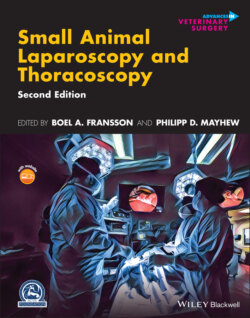Читать книгу Small Animal Laparoscopy and Thoracoscopy - Группа авторов - Страница 151
Optics
ОглавлениеWith the close proximity of the telescopes and instruments in single‐port surgery, adjustments are required to create space both internally and externally to avoid instrument and optic interference. The easiest way to avoid optics and instrument clashing during the procedure is the use of an angled telescope. The most common telescope used for single‐port laparoscopy in veterinary medicine is a telescope with a 30° angle. To further reduce the external clashing of instruments with the light cable, a right‐angle adaptor for the light cable can be used (Figure 6.10). Recently, the development of advanced laparoscopes geared specifically for single‐port surgery has emerged. A variety of deflectable telescopes with different mechanical design properties have recently been shown to be effective. One design involves a traditional fixed‐rod design that contains a rotating lens at the distal end (EndoCAMeleon, Karl Storz Endoscopy), or alternatively a design that uses the “chip on the tip” concept by placing an image processor at the distal tip of an articulating laparoscope (EndoEye, Olympus; Idealeye Stryker, Kalamazoo, MI) [72]. During veterinary single‐port surgery, it has been shown that using either a 30° telescope or an advanced deflecting optic enables the telescope's camera head and tip to be directed away from the other instruments during the procedure, improving working space while simultaneously maintaining excellent visualization.
